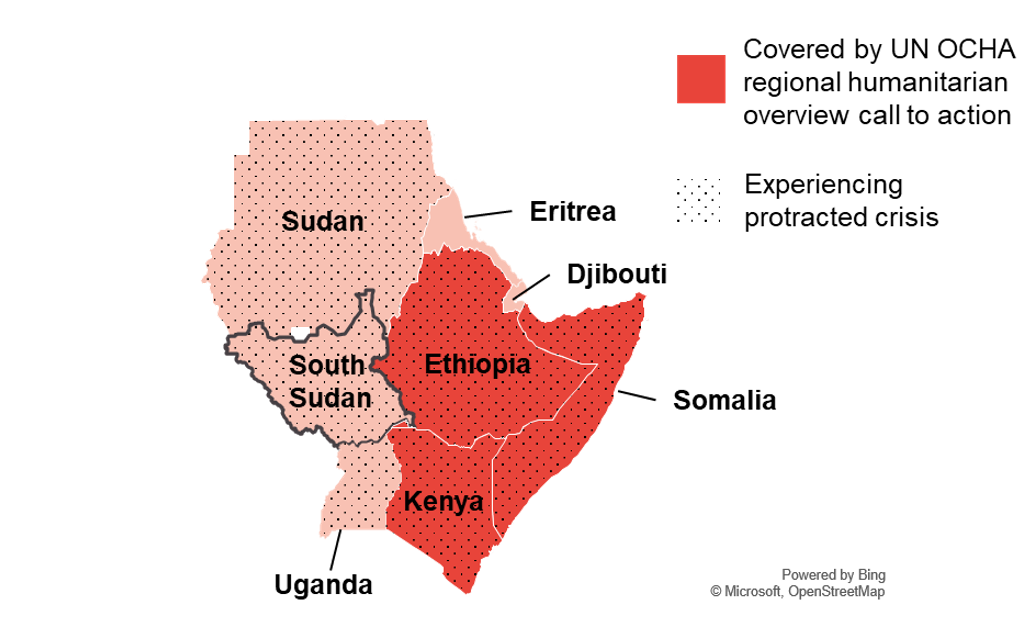Food insecurity in South Sudan: Funding to local actors
The Catholic Agency for Overseas Development (CAFOD) commissioned DI to conduct research into the role of local and national actors in the response to the current hunger crisis in South Sudan.
Acknowledgements
This report was commissioned by CAFOD. Research and analysis were completed by Development Initiatives in collaboration with CAFOD.
The authors of this report express their gratitude to the individuals and organisations that gave their time to share their insights and information which have informed the analysis in this report, including Tong Anei, Erica Mason and Dan Walton for Development Initiatives, The Titi Foundation, Africa Development Aid, Caritas Dioceses of Malakal and Rumbek, Nile Hope, the Hope Agency for Relief and Development (HARD) and The Organisation for Children’s Harmony (TOCH). Contributions to this research are anonymised in the text so that informants would feel able to share critical perspectives and discuss the challenges they face with current funding, partnership and decision-making processes. We also want to acknowledge the leadership of LNAs in convening thinking and engagement with donors, UN and INGOs through the NGO Forum Localisation Working Group and the Charter4Change South Sudan Working Group. Dialogue on issues raised by this research should centre their expertise and practical work to identify ways forward on localisation in South Sudan.
Executive summary
The Horn of Africa is facing a fifth consecutive failed rainy season, described as ‘a climatic event not seen in the last 40 years’. [1] Across the region, climate, conflict, and instability are driving the risk of deeper and longer crises impacting some of the least resilient populations, within the context of an expected global humanitarian funding shortfall of nearly US$25.5 billion in 2022. [2] The number of people assessed to be experiencing acute food insecurity in the Horn of Africa region has doubled since 2017, while South Sudan has the most severe food insecurity in the world, affecting 7.7 million people.
The contribution of local and national actors (LNAs) is fundamental to improving ‘the sustainability of interventions and resilience’. [3] This is especially important when crises are recurrent and protracted and it is therefore difficult to move beyond immediate humanitarian response into the recovery and reconstruction phases.
In 2016, the report ‘Missed Out: The role of local actors in the humanitarian response in the South Sudan conflict’ from Christian Aid, Cafod & Trocaire, Oxfam and Tearfund found that significant contributions of local and national actors to humanitarian action were constrained by a number of barriers, often compounded by the operating context. The report recommended that national actors be viewed as clear partners, with embedded roles in relevant humanitarian structures and that there was a consistent and prioritised investment in long-term partnerships. [4] Seven years later, in another cycle of drought, the reflections from LNAs in this briefing show that little has changed.
This briefing examines the extent to which local and national actors have been empowered and funded to respond to the current hunger crisis, with a particular focus on South Sudan alongside insights from other countries in the Horn of Africa region. It analyses:
- The level of food insecurity and climate vulnerability in South Sudan, nationally and sub-nationally
- The overall level of humanitarian funding and the typical sources for food sector humanitarian funding in the region
- How much of this funding has reached local and national actors
- The barriers and enablers that exist for accessing this funding
- The impact this funding could have on the current crisis.
In South Sudan, three years of consecutive flooding and low amounts of funding for agricultural programmes have contributed to a lack of resilience. This is evident as food security gains fail to be realised and the impacts of the crises continue to worsen across the Horn of Africa region.
Despite this worsening situation, overall humanitarian funding to South Sudan has stagnated since 2020. As of November 2022, food sector funding was declining in South Sudan and in Somalia, the two countries with the most severe food insecurity in the Horn of Africa region. This, accompanied by increases to food sector funding in Kenya and other East African countries, may be indicative of a strategic shift to more regional approaches or of the challenges presented by the contexts in South Sudan and Somalia.
LNAs have still managed to provide effective assistance but their efforts are severely impeded by the persistently low levels of funding that they have received. Annually across the Horn of Africa region, humanitarian assistance within the food sector that is provided directly to LNAs has not accounted for more than 5% of total food sector funding in any year between 2017 and 2022. During this six-year period, the US was the largest donor of food sector humanitarian funding to the region, providing over US$10.7 billion in funding. Only US$64.3 million (0.6%) of this went directly to LNAs without first going through intermediaries.
In South Sudan, the volumes and proportion of total humanitarian food sector funding received by LNAs are even smaller. Between 2017–2022, direct localised food sector funding totalled just $19.7m (0.4%). Three of the five largest donors to the food sector in South Sudan provided funding directly to LNAs. In total, this direct funding – from Germany, the United States and the United Kingdom – amounted to only US$2.8 million, just 0.1% of all food sector funding.
Country-based pooled funding is a significant source of funding to LNAs, but LNAs interviewed in South Sudan have highlighted the barriers to effective use of this funding for food security, not least among them that food security was not designated a priority. [5] Over 90% of funding for the food security and livelihoods cluster in South Sudan as of November 2022 came from the World Food Programme.
Just US$70m of trackable, localised food sector humanitarian funding has reached South Sudan since 2017 – including through pooled funds
Food sector humanitarian funding to LNAs

Scaled bubble chart showing US$19.7m direct localised funding, US$50.5m indirect localised funding, US$4.4bn non-localised funding.
Source: Development Initiatives based on UNOCHA FTS and UN CBPFs.
Notes: Levels of localisation are poorly reported beyond the first level of funding.
LNAs are still excluded from critical processes and from access to funding. While international agencies often call on local partners for baseline information and to implement food sector programming, their role in decision-making is still limited, and as a result responses to food insecurity fail to embed resilience.
There are limits to what humanitarian response can, and should be expected to, achieve. Contributions to humanitarian appeals habitually fall short of requirements, with levels of underfunding worsening. Even if fully funded, humanitarian appeals are conceived to provide life-saving measures but are not intended to embed long-term resilience. Preparing for and building resilience to food insecurity requires assistance beyond humanitarian response, from development and climate finance. In 2020, while resilience spending in the Horn of Africa region (US$2.5 billion) was equivalent to 45% of food sector spending (US$5.5 billion), in South Sudan resilience spending (US$127.8 million) equalled just 14% of food sector spending (US$899.6 million).
Funding to food resilience-building in South Sudan has made up just 11% of all humanitarian and development food sector spending since 2017
Development and humanitarian food sector funding
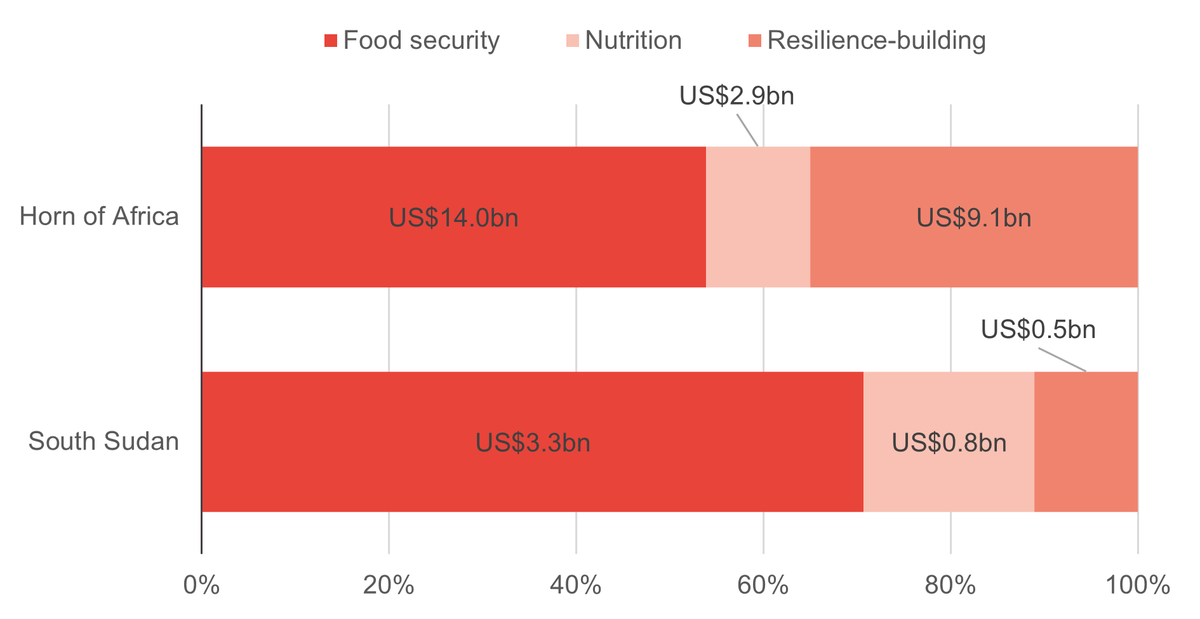
Bar chart showing funding by sector to South Sudan versus Horn of Africa region.
Source: Development Initiatives based on UNOCHA FTS, OECD DAC CRS and UN CBPFs.
Notes: Development funding data is only available up to 2020.
As East Africa enters another period of chronic drought with complex and context-specific causes and impacts, humanitarian responses must consider more than just the number of people facing food insecurity. While a relatively light-touch intervention may work in one context with a large population which has not yet reached the tipping point into protracted crises, a different approach will be needed in places where crises are worsening and deepening. Amid the continuing failure to utilise the proven and effective contributions of local and national actors, there is a need for mechanisms that prioritise their leadership, and to ensure a complex and coherent response from across the humanitarian, development, peace and climate nexus.
► Read more from DI about the food insecurity gap
► Share your thoughts with us on Twitter or LinkedIn
► Sign up to our mailing list
Introduction
The shocks of Covid-19 and the war in Ukraine have contributed to a spike in food and fuel prices across the Horn of Africa region, compounding the impacts of poor harvests. In 2022 and 2023, Kenya, Somalia and Ethiopia are projected to have over 36 million people affected by severe drought and acute food insecurity. [6] Many in the region are also facing a severe water shortage, malnutrition and the risk of disease, in addition to the deaths of nearly 9.5 million livestock in Kenya, Somalia and Ethiopia. [7] The surrounding countries of Sudan, South Sudan, Djibouti, Eritrea and Uganda are also, and will continue to be, impacted. In Ethiopia, Somalia, Kenya, Sudan, South Sudan and Uganda, these impacts are in addition to existing protracted crises. [8]
The 2022 drought follows two others in 2011 and 2016, but these cycles of crises also have feedback loops built within them, where factors such as conflict or the impacts of climate change not only drive crises but can themselves be caused or exacerbated by cycles of drought and food insecurity.
The situation in the Horn of Africa region is urgent, and varying metrics of food insecurity produce different suggestions for policy solutions. While Kenya, Ethiopia and Somalia are covered by OCHA’s Regional Humanitarian Overview and Call to Action (June 2022), [9] other countries in the region face intersecting dimensions of risk and protracted crisis. South Sudan, specifically, has consistently faced some of the world’s worst food insecurity. Continued conflict, unprecedented and widespread flooding, drought and shocks from failed harvests, gender-based violence (GBV) and other economic stressors seem only to be intensifying. [10] Malnourishment has surpassed levels experienced during conflicts in 2013 and 2016. In 44 counties in South Sudan, the nutrition situation is projected to deteriorate further in 2023. [11]
Food security
Acute food insecurity is faced by people who are unable to afford or access essential food needs, and presents the risks of malnutrition, starvation or death. While the risk of food insecurity is greater for those in humanitarian crisis contexts, a humanitarian crisis does not have to be present for countries to experience high levels of food insecurity.
There are a number of metrics which indicate the overall level of food insecurity in a country:
- The absolute size of a population facing food insecurity
- The size of a population facing food insecurity relative to the total population
- The intensity of the food insecurity felt by the population in need, as measured by the Integrated Food Security Phase Classification (IPC) acute food insecurity Phases 1–5.
The number of people at IPC Phases 3, 4 and 5 (crisis, emergency and catastrophe/famine) is a primary metric in tracking food insecurity and, along with other data sources such as humanitarian needs assessments, is used throughout this report as the definition of ‘food insecurity’.
Key drivers of food insecurity in the Horn of Africa region include:
- Climatic shocks (including floods and drought) that impact production and productivity
- Conflict and insecurity that disrupt supply chains and livelihoods
- Economic insecurity including a global context of rising inflation and food prices.
However, one of the most significant enablers of food insecurity in the region includes a scaled-back humanitarian response due to reduced investment, meaning there is little to no respite for the populations most severely affected. [12]
Localisation
The contribution of local and national actors (LNAs) is fundamental to improving ‘the sustainability of interventions and resilience’ of communities. [13] This is especially important when crises are recurrent and protracted, and it is difficult to move beyond immediate humanitarian response into the recovery and reconstruction phases. The Grand Bargain acknowledged the importance of processes that supported the participation of LNAs in delivering relevant, timely, effective and efficient humanitarian responses. This included an aggregated target of at least 25% of humanitarian funding channelled to LNAs directly from donors or as directly as possible. [14]
Yet transparency around how much funding reaches local actors remains elusive , particularly funding which passes through one or more intermediary organisation. A comprehensive picture of recipients, or even key sub-groups such as women-led and women’s rights organisations, is inhibited by poor reporting and data incompatibility. A lack of consensus on who ‘counts’ as a local actor also creates ambiguity around funding to local and national actors who may be – or have affiliation with – international organisations.
The need to properly resource and support local actors is more important than ever. However, what can be seen of funding flows shows that commitments to support a more locally-led humanitarian response have yet to be realised.
This briefing outlines the populations facing food insecurity in the Horn of Africa region [15] and the level of food insecurity they are facing. It traces the amount of food sector humanitarian funding they have received and the changes in that funding over time. It also measures the amount of funding from the development sector for agriculture and livelihoods, defined here as resilience building. The briefing specifically looks at the case of food sector humanitarian spending to local actors in South Sudan and, through interviews with several LNAs, sheds light on the availability and quality of funding they’ve received, the barriers and enablers to accessing that funding and the power of local and national actors to affect change when they are adequately supported.
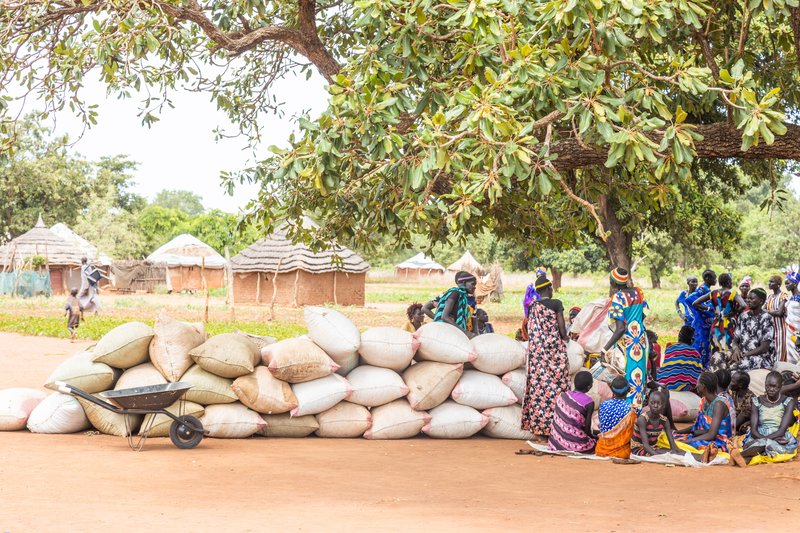
Humanitarian need and drivers of food insecurity
Figure 1: At least half of the countries in the region are experiencing three key dimensions of risk
Intersecting dimensions of risk in the Horn of Africa region
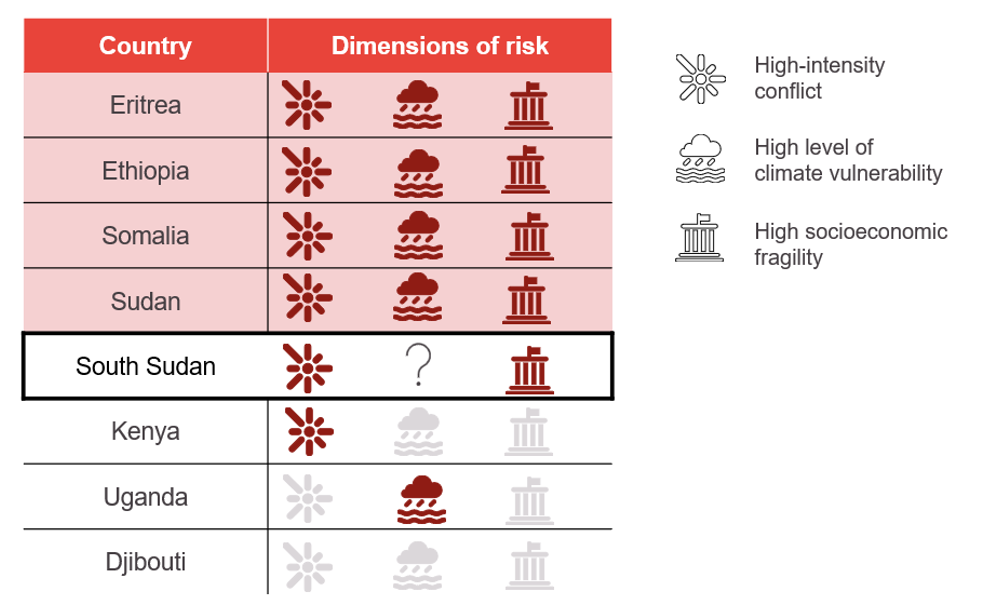
Designed table showing dimensions of risk being experienced by Horn of Africa countries. Shows that Eritrea, Ethiopia, Somalia and Sudan are experiencing high intensity conflict, high levels of climate vulnerability and high socioeconomic fragility.
Source: Development Initiatives based on Notre Dame Global Adaptation Initiative (ND-GAIN), Heidelberg Institute for International Conflict Research (HIIK), and OECD States of Fragility 2022.
Notes: Conflict risk is based on the presence of high conflict intensity (HIIK); high socioeconomic fragility is based on the top 20% of average social, human, economic and political fragility score (OECD); high climate risk is based on the top 20% of ND-GAIN score (ND-GAIN).
Intersecting dimensions of risk increase the likelihood of protracted crises and make a country more vulnerable to food insecurity. Countries in the Horn of Africa region are experiencing intersecting dimensions of risk and high levels of unmet humanitarian funding requirements that limit their ability to respond to crises. This may also have implications for funding to LNAs, as risks like socioeconomic fragility and conflict can serve as barriers to accessing funding. Overall humanitarian need has increased in the Horn of Africa region in the past three years, while levels of food insecurity have more than doubled between 2017 and 2022. At the same time the severity, or depth, of food insecurity (see Box 2: A note on the food insecurity gap) has also worsened.
Intersecting risks
Food insecurity is one of many risks that both lead to and result from protracted humanitarian need in the Horn of Africa region. Understanding where people in need are exposed to specific and intersecting risks can help to identify where the likely impacts of shocks may be greatest, and where we need more and better joined-up humanitarian, development, peacebuilding and climate interventions. Food insecurity is both a cause and a result of other risks such as climate vulnerability, socioeconomic fragility and conflict.
- Half of the countries in the region (Ethiopia, Sudan, Somalia and Eritrea) were experiencing all three dimensions of risk: climate vulnerability, socioeconomic fragility and conflict in 2021. [16]
- Conflict has been the preeminent driver of crisis in South Sudan, and the 2013–2020 conflict a major intensifier. [17] However, South Sudan’s climate vulnerability is not currently tracked and LNAs interviewed in South Sudan cite three consecutive years of unprecedented flooding, followed by drought, as a significant driver of food insecurity (see Box 1).
Box 1
Conflict, climate and culture as drivers of food insecurity in South Sudan
The delivery of food and livelihood assistance in South Sudan has been disrupted by three years of consecutive flooding, localised conflict, and youth agitation. [18] Conflict over food production, land and water drives and exacerbates food insecurity and creates an operating environment with little trust, where external or cross-border threats can impact the delivery of humanitarian assistance and perpetuate crises. [19]
In 2022, South Sudan was estimated to have a relatively low risk of natural hazards. However when multiple factors, such as conflict and fragility, are aggregated, it ranks among the top ten countries with the highest level of exposure to risk, which suggests a low coping capacity against climate and other shocks. [20] LNAs interviewed in South Sudan all cited unprecedented flooding as one of the main drivers of the current food security crisis. [21] The flooding destroys existing crops such as groundnuts, cowpeas and sorghum, as well as food stores, livestock and shelter. [22] LNAs interviewed in South Sudan suggested that conflict is a barrier to the effective delivery of humanitarian response to food security crises. [23]
South Sudan remains one of the top ten countries in the world with the worst life expectancy, at 58 years. [24] 80% of households in South Sudan are female-headed and 60% of the population are youth. Gender-based violence (GBV) related to both food insecurity and conflict is a key threat, exacerbated by flooding and limited livelihood opportunities. [25] Women are an integral part of the farming system and play a key role in activities related to food security. [26] Risks related to women therefore have an impact on food insecurity. However, as of November 2022, the protection cluster has been only 27.4% funded (US$282.7 million). [27]
LNAs interviewed in South Sudan have said that unprecedented flooding has exacerbated existing crises at national and subnational levels and prevented activities which would build resilience. [28] In addition to a lack of food at the household level, there have been shortages of commodities that typically come from neighbouring countries. Such commodities are themselves affected by the global stressors of Covid and the crisis in Ukraine and in some cases may be physically inaccessible due to flooding or border conflicts. Concern about the Ebola outbreak in Uganda has also affected access to goods in regions that border Uganda. [29]
Humanitarian need
The number of people in need in the Horn of Africa region has steadily increased since 2017. Since 2020 and the onset of the Covid-19 pandemic, the consistency of funding to humanitarian appeals has declined, with increasing levels of unmet funding requirements. [30]
- In the 8 countries that make up the region, there were an estimated 63.7 million people in need of humanitarian assistance in 2022, over 20% of the estimated global total and a year-on-year increase of 2 million (from 61.7 million), from 2021. South Sudan accounted for more than a fifth of those in both 2021 and 2022. [31]
- In 2022, there were Humanitarian Response Plans (HRP) for 4 of these countries – Ethiopia, Somalia, South Sudan and Sudan – which were collectively 52% funded (US$4.8 billion of US$9.2 billion). [32]
- The Horn of Africa (Kenya, Somalia and Ethiopia) drought had an additional appeal in 2022 for US$3.4 billion to target 25.4 million people facing food insecurity and malnutrition. As of November 2022, this appeal was 56% (US$1.9 billion) funded.
- 2.3 million South Sudanese refugees living across 5 main asylum countries (Sudan, Ethiopia, Kenya, Uganda and the DRC) were also the target of a regional coordinated appeal. [33] As of November 2022, the US$873.3 million appeal was 56% funded (US$487.2 million). [34]
Of the 4 countries with HRPs in 2022, South Sudan’s, which targets 8.3 million people, was the best funded (67.3%, US$1.2 billion of US$1.7 billion as of November 2022). [35] While the amount of humanitarian assistance in South Sudan has remained consistent for three consecutive years, the number of people in need has steadily increased. In 2021, an HRP targeting 8.3 million people for US$1.7 billion was 68% funded (US$1.2 billion) and in 2020, an HRP targeting 7.5 million for US$1.9 billion was 65% funded (US$1.2 billion). [36] This proportion of funding demonstrates stagnating funding for South Sudan and supports the IPC assertion that a reduction in the amount of humanitarian funding could be exacerbating the situation. [37]
Food insecurity
The largest populations and the populations facing the most severe forms of food insecurity globally are in the Horn of Africa region. In 2022, an estimated 53.8 million people are assessed to be facing acute food insecurity, a year-on-year increase of 34% (from 40.1 million in 2021).
Figure 2: The number of people experiencing acute food insecurity has more than doubled since 2017
Number of people facing acute food insecurity
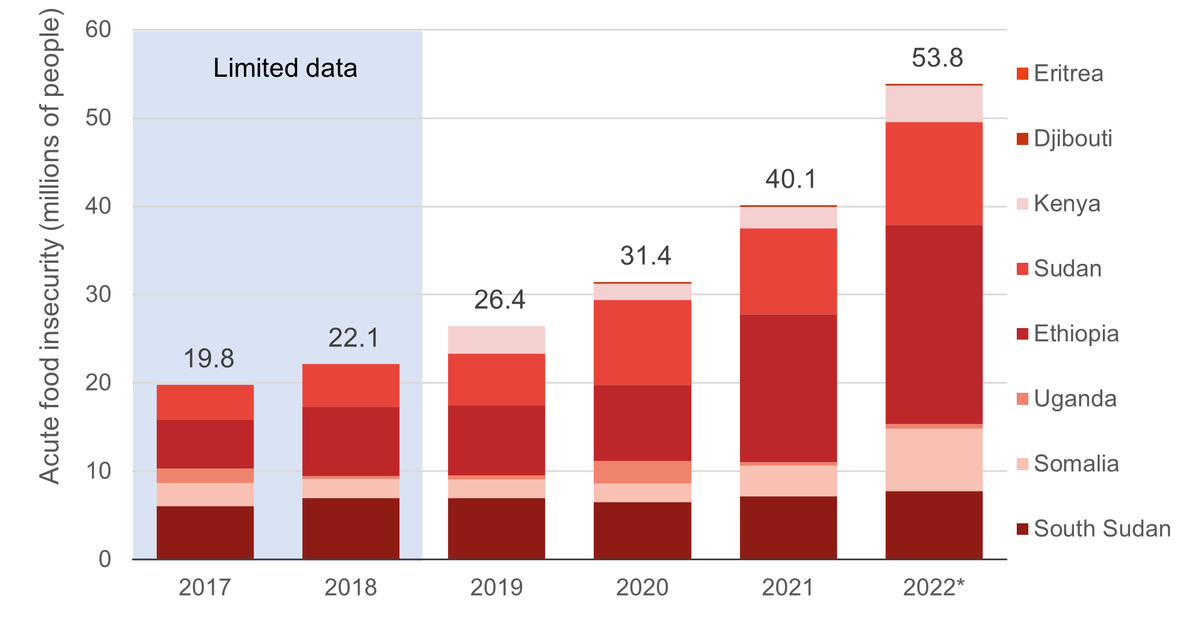
Stacked column chart showing number of people experiencing food insecurity in Horn of Africa countries each year from 2017 to 2022.
Source: Development Initiatives based on Integrated Food Security Phase Classification (IPC) / Cadre Harmonisé (CH), and UN OCHA Humanitarian Needs Overviews.
Notes: *2022 data is preliminary. Data combines results from IPC/CH assessments and UN-coordinated HNOs, which may use differing definitions of food security.
- Food insecurity in the Horn of Africa region has nearly doubled in the last six years from 19.8 million people in 2017 to 53.8 million people in 2022.
- In 2022, 3 countries in the Horn of Africa region were among the top 10 in the world with the largest populations facing food insecurity (Ethiopia – 22.6 million, Sudan – 11.7 million, and South Sudan – 7.7 million). 2 others (Somalia – 7.1 million, Kenya – 4.4 million) were in the top 25.
- The largest increases were in Ethiopia (from 16.8 million people in 2021 to 22.6 million people in 2022) and Somalia (from 3.5 million people in 2021 to 7.1 million people in 2022).
- From 2021 to 2022, the number of people facing acute food insecurity in South Sudan increased by 500,000 people (from 7.2 million to 7.7 million people).
In every country in the Horn of Africa region, the severity of food insecurity has increased since 2019. Somalia experienced the largest increase in its food insecurity gap (see Box 2: A note on the food insecurity gap) between 2019–2022, where it increased from 7% to 20%, indicating an increasing severity of the food insecurity experienced by the affected population.
In 2022, 3 countries in the Horn of Africa region were among the top 10 in the world with the greatest food insecurity gaps (South Sudan – 29%, Somalia – 20% and Uganda – 16%). This meant they had the highest average shares of the population experiencing the most severe food insecurity.
Figure 3: South Sudan has consistently been home to people facing the most severe food insecurity in the world
Acute food insecurity, numbers of people and gaps, in the Horn of Africa region
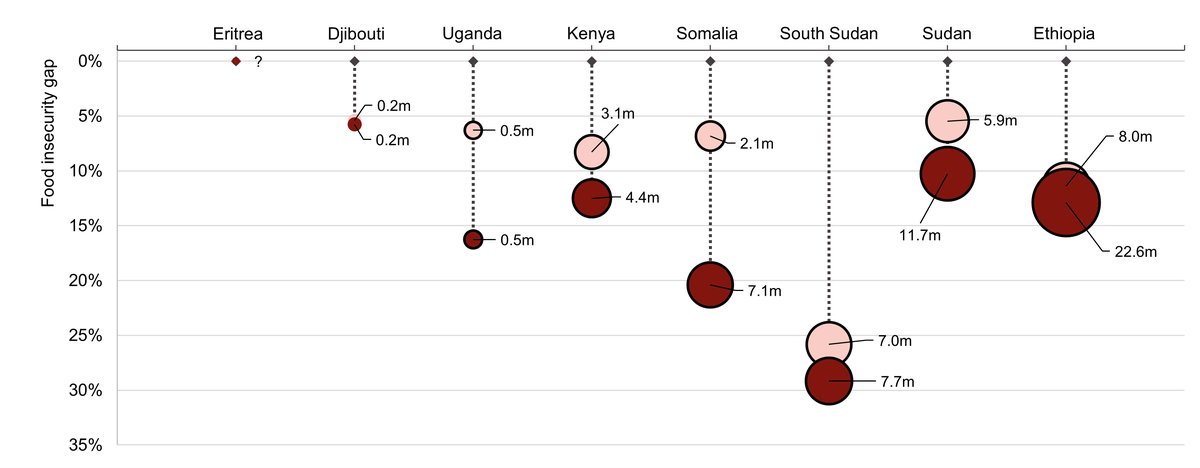
Bubble chart showing food insecurity gap in Horn of Africa countries including numbers of people experiencing food insecurity in 2021 and 2022.
Source: Development Initiatives based on Integrated Food Security Phase Classification (IPC) / Cadre Harmonisé (CH).
Notes: 2022 data is preliminary. Bubbles are scaled according to total population in food insecurity (phase 3+). Depth is calculated based on a modified Foster-Greer-Thorbecke (α = 1) index across the food-insecure assessed population using a critical threshold of phase 3.
As of November 2022, the food security and livelihoods cluster in South Sudan had the highest requirements (US$650 million) and was 80% funded (US$521 million). Nearly US$476 million of this funding comes from the World Food Programme, [38] who provide food and nutrition assistance as well as resilience building activities such as the construction of dykes and restoration of key roadways. [39] Interviews with LNAs suggest that this resource is overstretched. [40]
Figure 4: Subnational regions in South Sudan have significant variation in the severity of food insecurity experienced
Acute food insecurity by region in South Sudan
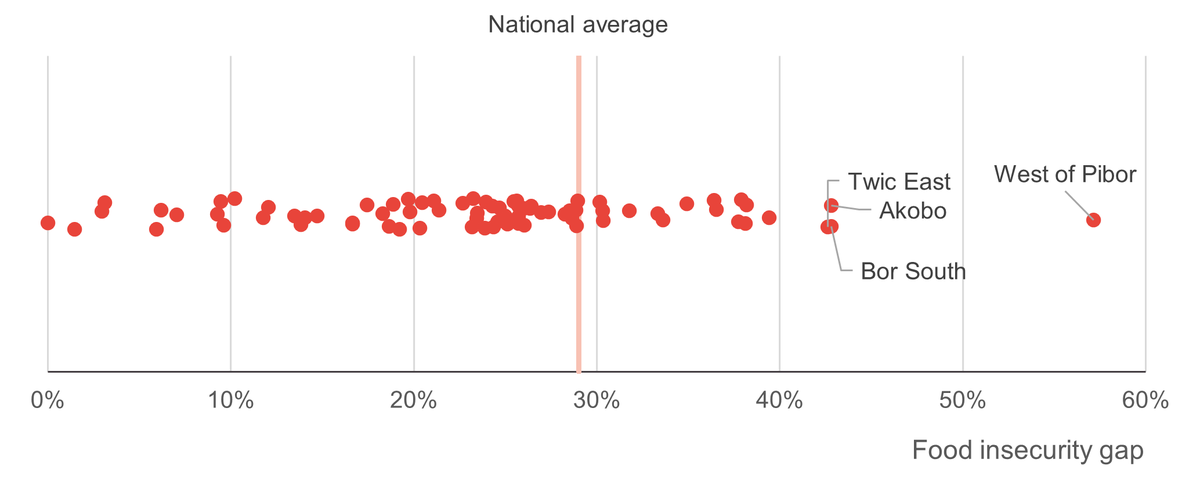
Scatter chart showing variation in severity of food insecurity experienced in regions of South Sudan. Labelled data points are Twic East, Akobo, Bor South and West of Pibor, which have the highest food insecurity gap (over 40%).
Source: Development Initiatives based on Integrated Food Security Phase Classification (IPC) / Cadre Harmonisé (CH).
Notes: 2022 data is preliminary. Depth is calculated based on a modified Foster-Greer-Thorbecke (α = 1) index across the food-insecure assessed population using a critical threshold of phase 3.
In 2022, South Sudan faced its fifth recorded year of severe food insecurity according to the IPC, with over half (54%) of its total population (14.3 million) experiencing food insecurity. [41] While South Sudan has the most severe levels of food insecurity in the world, looking at acute food insecurity by region shows the majority of subnational areas as having a lower food insecurity gap than the national average of 29%. The national average is skewed by a few regional populations at more intense levels of food insecurity, such as West of Pibor, Bor South, Akobo and Twic East. [42]
LNAs interviewed in South Sudan have noted that swift anticipatory action is possible as subnational areas at the greatest levels of need have been identified. Even with money earmarked for food security crises, these LNAs report that delays or poor targeting often inhibit the benefit that could be achieved from their early identification of those communities most at risk. [43]
Box 2
A note on the food insecurity gap
There are two key factors to consider when assessing food insecurity: the size of the populations facing food insecurity, and the severity at which they experience it. The largest populations facing food insecurity may not be experiencing it to the same intensity as those with a greater food insecurity gap – a single percentage figure that quantifies the relative difference in populations experiencing IPC Phase 3, 4, and 5 levels of acute food insecurity. Those with greater food insecurity gaps, and therefore more severe food insecurity, may require a different and more urgent set of interventions.
A food insecurity gap can be calculated for any population with adequate food insecurity data – both nationally and subnationally. A population with a greater relative proportion of people facing more severe food insecurity will report a higher gap than a population with a lower average severity of food insecurity. A gap of 0% indicates that no-one is facing IPC Phase 3 or higher, and 100% indicates that everyone is facing Phase 5. Most countries when assessed return a value of 5–20% for their national gap, while the most severely food-insecure subnational regions may score over 50%. South Sudan, and particularly the population in the west of Pibor, are experiencing the most severe food insecurity in the world, with continuous famine-like conditions year-on-year.
Measuring how the intensity of food insecurity differs and changes between populations is vital to understanding and comparing levels of need, and tracking progress over time. Countries experiencing some form of crisis – new, recurrent or protracted – typically have worse food insecurity than others.
The response to food insecurity
Food sector humanitarian funding
Figure 5: Food sector funding accounts for over half of all international humanitarian assistance to the Horn of Africa
Food sector funding as share of total international humanitarian assistance

Stacked column chart showing that food sector funding accounts for over half of all humanitarian assistance to the region.
Source: Development Initiatives based on UNOCHA FTS and UN CBPFs.
Notes: *2022 data is partial, and subject to change.
The Horn of Africa region has over US$6.3 billion in unmet humanitarian funding requirements in 2022, is facing multiple dimensions of risk and has 13.7 million more people facing acute food insecurity in 2022 than in 2021 – half a million of them in South Sudan. In 2022, international humanitarian assistance to the Horn of Africa decreased, but the proportion for food sector humanitarian spending increased. Between 2021 and 2022, spending on food sectors increased by an estimated 10% in both South Sudan and the wider region.
- In 2021, 51% of international humanitarian assistance (US$2.8 billion of US$5.4 billion) in the region was food sector spending. As of November 2022, this figure is an estimated 60% (US$2.9 billion of US$4.9 billion). This represents an increase of US$172 million for food sector humanitarian spending, but an estimated decrease for all other humanitarian activities of US$779.3 million. [44]
- South Sudan received US$1.4 billion in 2021, the second highest amount of humanitarian funding in the region. As of November 2022, South Sudan has received US$867.5 million in total humanitarian assistance, a year-on-year decrease of nearly US$547 million. [45]
- The trend of an increasing portion of international humanitarian assistance for food sector spending was reflected in South Sudan, even while money for the food sector decreased. In 2021, 50% of international humanitarian assistance to South Sudan ($712.4 million of US$1.1 billion) was food sector spending. In 2022, this figure is an estimated 59% of total in-country international humanitarian assistance (US$509.5 million of US$867.5 million). This represents both a decrease in real terms on food sector humanitarian spending of nearly US$203 million and an estimated decrease for all other humanitarian activities of US$344 million. [46]
Food sector funding by country and per capita
Figure 6a: Since 2020, South Sudan has received less food sector humanitarian assistance while other countries have been receiving more
Food sector humanitarian spending – South Sudan, Kenya, Somalia
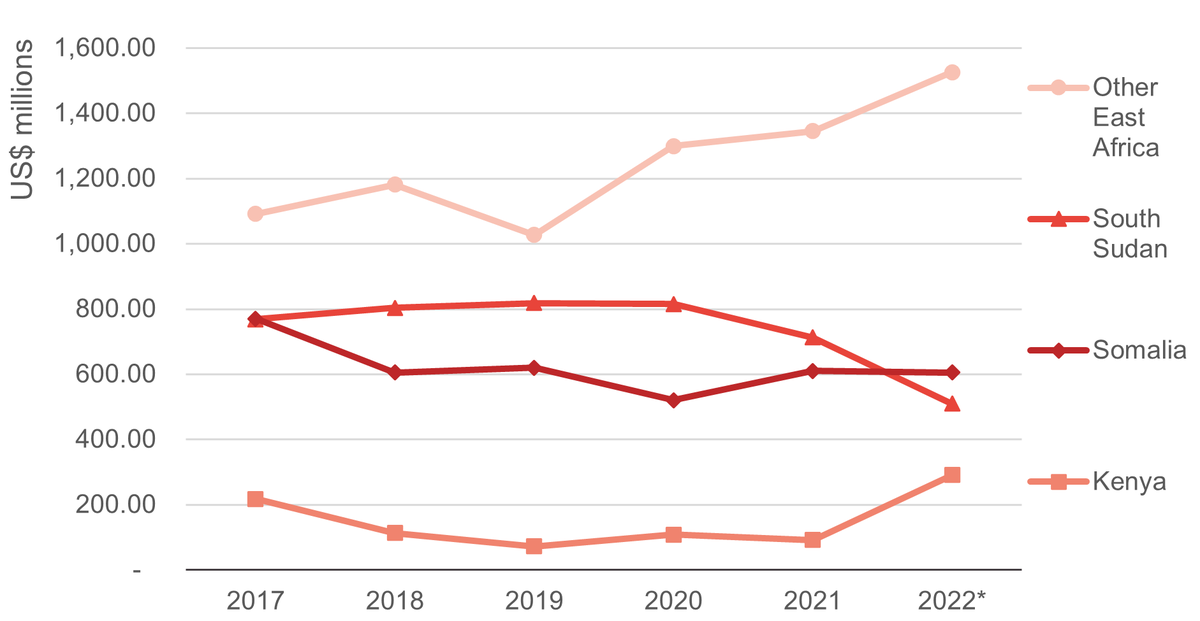
Line chart showing trends in food sector funding in South Sudan, Somalia, Kenya and other East African countries. Decline in South Sudan contrasts with growth or stagnation in all others.
Source: Development Initiatives based on UNOCHA FTS and UN CBPFs.
Notes: *2022 data is partial, and subject to change.
While overall food sector humanitarian funding to the region has been increasing since 2018, the breakdown of where it is spent (by country) has changed. From 2020 to 2021, South Sudan saw a decrease in food sector funding of US$103.2 million (from US$815.6 million to US$712.4 million).
As of November 2022, despite plateauing in Somalia (US$605.7 million), food sector spending to Kenya (US$290.7 million) and other countries in the Horn of Africa region (US$1.5 billion) has already overtaken spend in 2021. In the case of Kenya, the estimated increase of US$198.8 million is almost equal to the estimated decrease of funding to South Sudan by the same date in 2022 (US$202.9 million), possibly reflecting a change in priorities or programming.
Figure 6b: Ethiopia has experienced an increase in food sector humanitarian spending, while South Sudan has experienced an almost equivalent decrease
Food sector humanitarian spending – Ethiopia and South Sudan
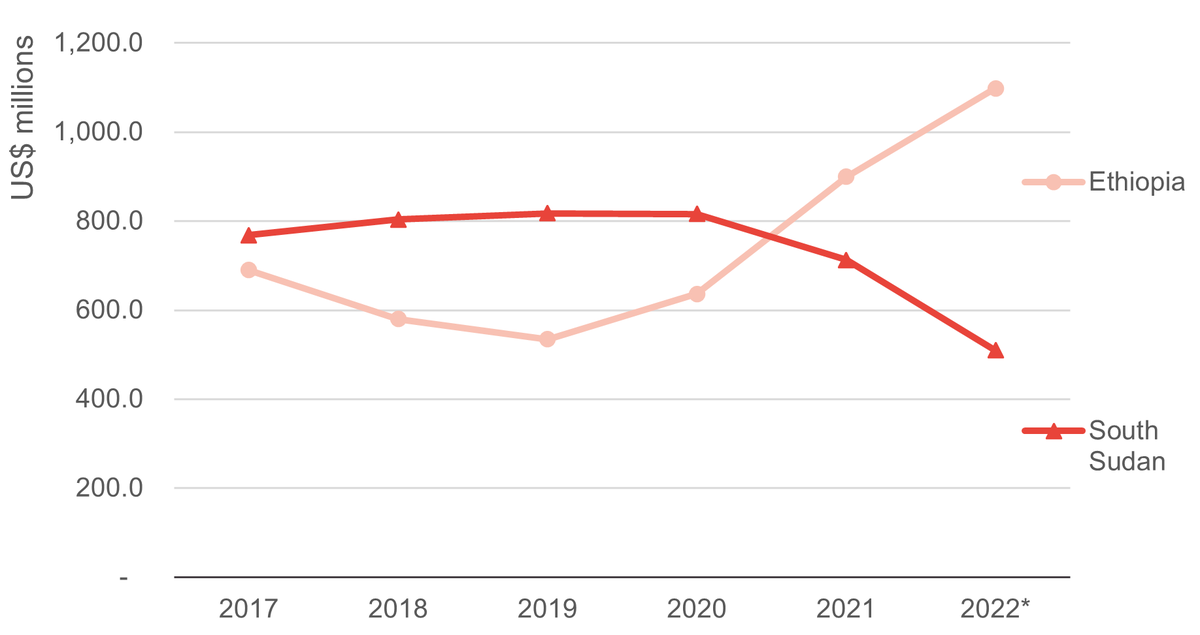
Line chart contrasting Ethiopia's food sector humanitarian spending with South Sudan's. Ethiopia shows consistent increase from 2019 with almost equivalent decrease in South Sudan from 2020.
Source: Development Initiatives based on UNOCHA FTS and UN CBPFs.
Notes: *2022 data is partial, and subject to change.
The difference between Ethiopia and South Sudan from 2019–2022 is even more pronounced. After the current conflict began in Ethiopia in 2020, funding for food sectors increased by 19% (from US$534.6 million to US$636.6 million in 2021) and is estimated to increase a further 72.6% to US$1.1 billion. During the same period, funding for food sectors in South Sudan is estimated to decrease by nearly 38% (from US$817.7 million to US$509.5 million).
The estimated difference in funding for food sectors between Ethiopia and South Sudan in 2022 is US$589 million and represents just over the amount of estimated food sector spending in South Sudan in 2022. This shift in funding could be related to the 2022 Horn of Africa Drought Appeal, which includes Kenya, Ethiopia and Somalia and has nearly US$3.4 billion in requirements. [47] However, this shift does not reflect the food insecurity gap, which is nearly 9 percentage points worse for South Sudan (29%) than it is for Somalia (20%), and nearly 16 percentage points worse than Kenya and Ethiopia (both 13%). While larger numbers of people are facing food insecurity in Ethiopia than in South Sudan (in 2022, 22.6 million compared to 7.7 million respectively), overall food insecurity within the affected food insecure population in Ethiopia is less severe. In addition, compared with South Sudan, there are almost 600,000 fewer people experiencing less severe levels of food insecurity in Somalia, and 3.3 million fewer people experiencing less severe levels of food insecurity in Kenya.
The differences in the food insecurity gap and changes in funding to countries in the region could reflect changes in priorities, and more research is needed to determine whether the size of the population facing acute food insecurity, the severity of food insecurity, or other considerations such as the complexity of operating environments or intersecting levels of risk or crisis are influencing policy choices.
Figure 6c: All countries in the Horn of Africa region, except Kenya, have seen decreasing levels of food sector humanitarian funding per person facing food insecurity, with Somalia dropping the most
Food sector humanitarian funding per person facing acute food insecurity

Line chart showing decrease in food sector spend per person facing food insecurity in South Sudan, Somalia and Ethiopia. Somalia shows most drastic drop. Kenya is only line to show increase.
Source: Development Initiatives based on UNOCHA FTS, UN CBPFs, IPC/CH, and UN OCHA HNOs.
Notes: *2022 data is partial, and subject to change.
While comparisons in aggregate food sector humanitarian spending to countries might suggest a shift in priorities, food sector humanitarian spending per capita has decreased in places that by specific food security metrics are most in need of humanitarian assistance. Per capita spending has decreased in Ethiopia, the country with the largest increase in the population facing food insecurity (from US$54 in 2022 to US$49 in 2021), South Sudan, the country with the highest food insecurity gap (US$99 to US$66) and Somalia, the country with the biggest declines in food security overall (US$176 in 2021 to US$86 in 2022). [48]
In Kenya, where the number of people facing food insecurity has nearly doubled from 2021 to 2022 (2.4 million in 2021 to 4.1 million in 2022), per capita food sector humanitarian spending also almost doubled from US$39 to US$70. However, Kenya did not experience increases as large as Ethiopia and Somalia in the number of people facing food insecurity, has a similar food insecurity gap to Ethiopia and fewer intersecting dimensions of risk than other countries in the Horn of Africa region. Kenya’s increase in both aggregate food sector humanitarian spending and per capita spending are not readily explicable compared to Somalia, South Sudan and Ethiopia. Possible explanations for this shift in per capita funding toward Kenya could include a movement toward a more regionally led approach to food insecurity, but more research needs to be done into policies that impact on food sector humanitarian spending in the region.
Funding to LNAs
Localisation is meant to decentralise and redistribute authority, capacity and funding in an attempt to make humanitarian interventions more responsive and more financially and politically sustainable. [49] There is consensus across the sector that ‘good’ localisation is inclusive of the Grand Bargain commitment of 25% funding to LNAs and involves less subcontracting, better institutional development, and the increased presence and influence of LNAs in a framework for best practice. [50]
There is very little food sector funding paid directly from donors to LNAs in the Horn of Africa region. Overall, less than 5% of food sector funding in the region was disbursed to LNAs, and in South Sudan the figure has been around 2% since 2019. For both the region and South Sudan, the highest proportion of funding to LNAs (4.9% and 3.4% respectively) was in 2017, the year after the Grand Bargain. LNAs interviewed in South Sudan describe barriers to funding that can address immediate needs such as long application times and the need to translate into the donor country’s language. [51]
Funding to LNAs can be direct or indirect: it can be channelled straight from the donor to a local implementing organisation, or channelled through at least one intermediary or pooled fund before reaching a local implementing organisation. However, tracking of indirect funding is incomplete, with over 90% of direct funding reported to FTS lacking further information on where resources may have been subsequently passed to another organisation. LNAs interviewed in South Sudan noted that the number of national partners in pooled funds decreased dramatically after the establishment of the global guidelines on pooled funds – from over 70 in 2018 to 15 in 2020 and 14 in 2022. [52] Furthermore, the limited contributions of international NGOs to pooled funds often means that there is less money available for projects, which encourages short term projects with smaller impacts. LNAs interviewed in South Sudan noted that the amount of support LNAs receive from pooled funds depends on the commitment of the fund managers to the localisation agenda. [53]
LNAs interviewed in South Sudan noted that food insecurity in 2022 was at its most extreme levels since independence in 2011, [54] and that they are overwhelmed by the number of requests they receive for food and non-food items. [55] There has been a shift in migration patterns – people are migrating not because of conflict but because of hunger – putting stress on other subnational and cross-border areas that may themselves be experiencing intersecting dimensions of risk and food insecurity. [56] LNAs interviewed in South Sudan have noted that while funding toward food insecurity has not changed much in the last three years, the needs are increasing overall, leading to an estimated reduction in available resources from donors in some cases by as much as a 30%. [57]
Figure 7a: Localised food sector humanitarian funding to the Horn of Africa has not exceeded 5% annually, with South Sudan seeing even lower than regional levels
Food sector humanitarian funding, direct and indirect to LNAs
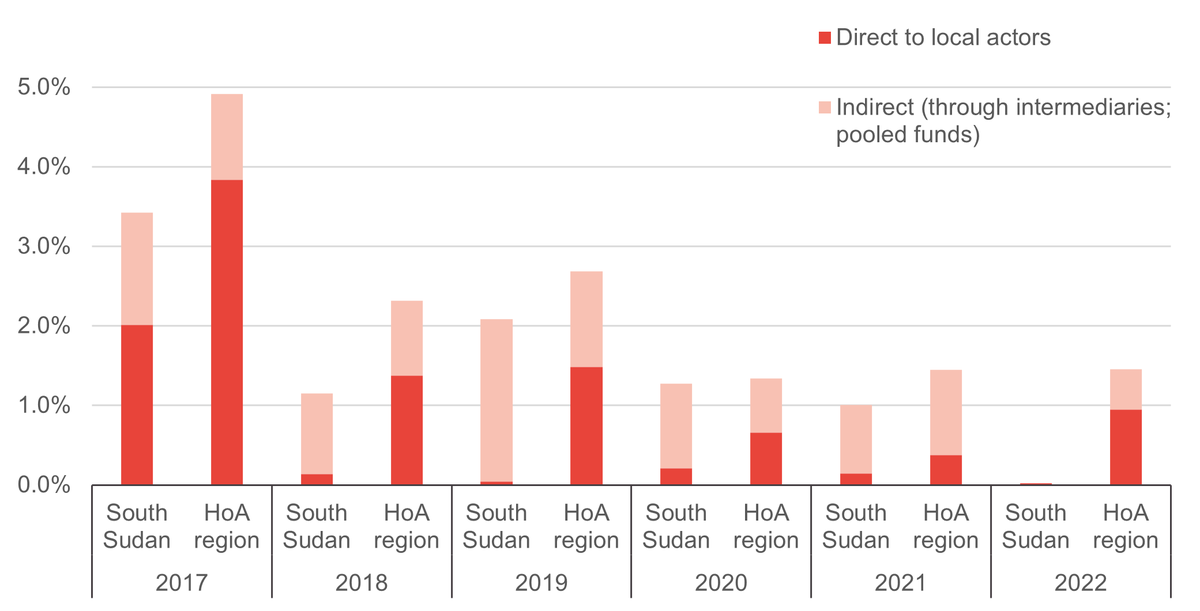
Stacked column chart displaying year-on-year comparison of direct and indirect food sector funding to LNAs in South Sudan against Horn of Africa region. South Sudan consistently shows lower levels of funding than the rest of the region.
Source: Development Initiatives based on UNOCHA FTS and UN CBPFs.
Notes: *2022 data is partial, and subject to change. Levels of localisation are poorly reported beyond the first level of funding.
In the response to food insecurity in South Sudan, LNAs interviewed described localisation efforts as falling far short of these emerging indicators. Relatively few local actors are given the opportunity to lead or be active in clusters, where decisions are made and power is distributed. [58] The food security and livelihoods cluster was the first to take up local organisations in a coordination role, but its originating coordinator has since stepped down. In some cases, LNAs interviewed for this briefing felt that responding to conflict was more of a priority for international organisations than food security, suggesting that funding could be better targeted and highlighting how conflict can interfere with humanitarian responses to food security. [59]
LNAs can be cost effective, have a better understanding of the context, have far-reaching networks and legitimacy in the communities, as was seen in the case of Covid-19 in 2021. [60] To LNAs in South Sudan, localisation is not just about programmatic co-design, but also access and control over funding. [61]
Box 3
Access by local actors to crisis-affected populations
LNAs are often present where international agencies cannot operate and therefore take on a higher level of risk. In partnership with other influential community actors such as faith leaders, LNAs can impact delivery through activities such as negotiating access, which can, in turn, open up new sources of funding.
In 2016, the conflict in Juba spread to the Central Equatoria Region of South Sudan and international partners withdrew. By 2017, 42% of people in the region were assessed to be facing food insecurity. The Titi Foundation worked with the Catholic Archdiocese to reopen the area to humanitarian response by negotiating with each of the factions during the conflict and through the Church as partners. The negotiations resulted in mutual agreement that aid workers would receive safe passage between areas held by different parties to the conflict, and that there would be a temporary ceasefire during the period of activity. Each party would escort the aid workers to the conflict border, where they would be met by another party. This opened a pathway to deliver needed humanitarian response from 2016–2020 that was reliable enough for other national and international NGOs to use, sometimes through joint interventions with the Titi Foundation that would ensure security.
After the pandemic began in 2020, free movement was more assured and the need for facilitation from the Titi Foundation decreased. This particular case demonstrates both how the conflict impacts on the delivery of humanitarian assistance and the risks LNAs face in ensuring its delivery, but also how LNAs can negotiate and build trusted relationships with other stakeholders to make progress.
Further, this role as intermediary between international agencies and areas affected by conflict can open up more funding for LNAs. After international agencies withdrew due to spiralling violence in neighbouring Pibor county, one donor launched a call for proposals from LNAs responding to the crisis.
Food security programmes with local actors are funded in part through the UN-OCHA South Sudan Humanitarian Fund (SSHF), which had an allocation of US$25 million in July 2022 to address the impact of violence and food insecurity in ten counties of the four worst-hit states: Warrap, Jonglei, Unity and Western Equatoria states. [62] Eligibility for this fund includes that applicant NGOs have participated in rolling years’ HRPs and have a programmatic/budget expenditure for the previous 24 months of at least/equal to US$200,000 – criteria that limit the eligibility of many smaller LNAs.
A process led by OCHA to shift the SSHF from funding smaller projects to fewer, larger-scale multi-sectoral projects resulted in the reduction of support for LNAs and of their scope to lead on SSHF projects. LNAs interviewed in South Sudan noted that OCHA’s approach to coaching LNAs during the associated risk realignment exercise was not optimal; as a consequence LNAs ended up less able to directly access SSHF grants than previously. They also noted that these challenges have been accentuated by the lack of wider investment in LNAs by other actors to strengthen capacity and build systems which would allow them to take on larger grants. In 2022 so far, none of the fund’s allocation has gone to food sectors. As of November 2022, the SSHF listed only two funding recipients in 2022 – US$700,000 to Solidarités International for WASH programmes, and nearly US$12 million to the WFP, US$9 million of which was for cargo transport to vulnerable populations in hard-to-reach locations. [63]
Organisations that are able to acquire funding describe it as transformative, allowing them to determine priorities related to resilience building, reach additional locations and respond more quickly to emergent situations. Yet the US$25 million allocated to the fund is only a fraction of the US$650 million required funding for the food security and livelihoods cluster. LNAs interviewed in South Sudan cited a sense of competition amongst all actors, at every level, for a limited pool of funding. [64]
The size of the overall funding pool for the food sector and the security situation were both cited by LNAs interviewed in South Sudan as reasons for a continued ‘subcontracting’ relationship with local actors, who were dependent on international organisations for access to funding and who found difficulty recruiting and retaining staff due to both the lack of overheads and the short funding cycles. Interventions were seen as largely donor-driven, with inadequate consultations of the affected or vulnerable communities. [65]
However, what is apparent from LNA interviews in South Sudan is that the contribution of LNAs could go far beyond facilitating interventions with the community and providing needs-based and other crisis-related contextual information, including:
- Continuous, context-specific baseline assessment and programme development
- Humanitarian interventions such as evacuation and relocation of internally displaced persons (IDPs)
- Mobilisation of resources and provision of basic supplies and assistance
- Security regimes and protocols
- Risk assessments and impact evaluations for both crisis and programming
- Development of communication strategies for various stakeholders, from local to international audiences
- Capacity- and resilience-building to avoid cycles of crisis.
Box 4
LNA contributions to cash and voucher assistance (CVA) programmes in South Sudan
The Organization for Children Harmony (TOCH) in Gogrial, Warrap State and Caritas Diocese of Rumbek (CDoR) in Yirol East and Lakes State have made important contributions to CVA programming, reaching over 300,000 people over the past year. Both organisations operate in hard-to-access remote parts of the country where there are no other humanitarian agencies present. In Greater Tonj, TOCH is the only agency present and assisting people affected by the crisis there.
Both TOCH and DCoR bring long-term and deeply-rooted relationships with the local community; for example through TOCH’s longer-term psycho-social and peacebuilding programming, and through CDoR’s longer-term WASH programming but also its link to the Church, which has a level of access, trust and respect across South Sudan that most humanitarian organisations cannot replicate.
The Multi Sector Survival Minimum Expenditure Basket (SMEB) is used to determine the value of cash transfer per household. The cost of SMEB is updated regularly through Joint Market Monitoring Initiative (JMMI). The local knowledge and community networks of national NGOs is of critical importance when assessing the feasibility of CVA in the target area, as well as when designing the CVA approach in that context, factoring in a market assessment, beneficiary needs assessments, and attention to protection mainstreaming.
Mechanisms are established to enable feedback and complaints about how the programme was delivered and the project team. Post Distribution Monitoring (PDM) assessments are also conducted immediately after cash distribution to assess satisfaction of recipients and how the cash was utilised.
The expertise that TOCH and CDoR bring informs the assessment of risks; including safety of carrying and using cash; exclusion due to age, disability, or ethnicity; household or community conflict over cash; and anti-social use of cash. One example of this expertise is in determining the protection risks in places like Tonj North, where the programme switched from cash to food distributions based on TOCH’s analysis.
Figure 7b: The top 5 donors of food sector funding to the Horn of Africa have provided very little direct funding to local and national actors
Direct food sector humanitarian funding to LNAs by top 5 donors, 2017–2022
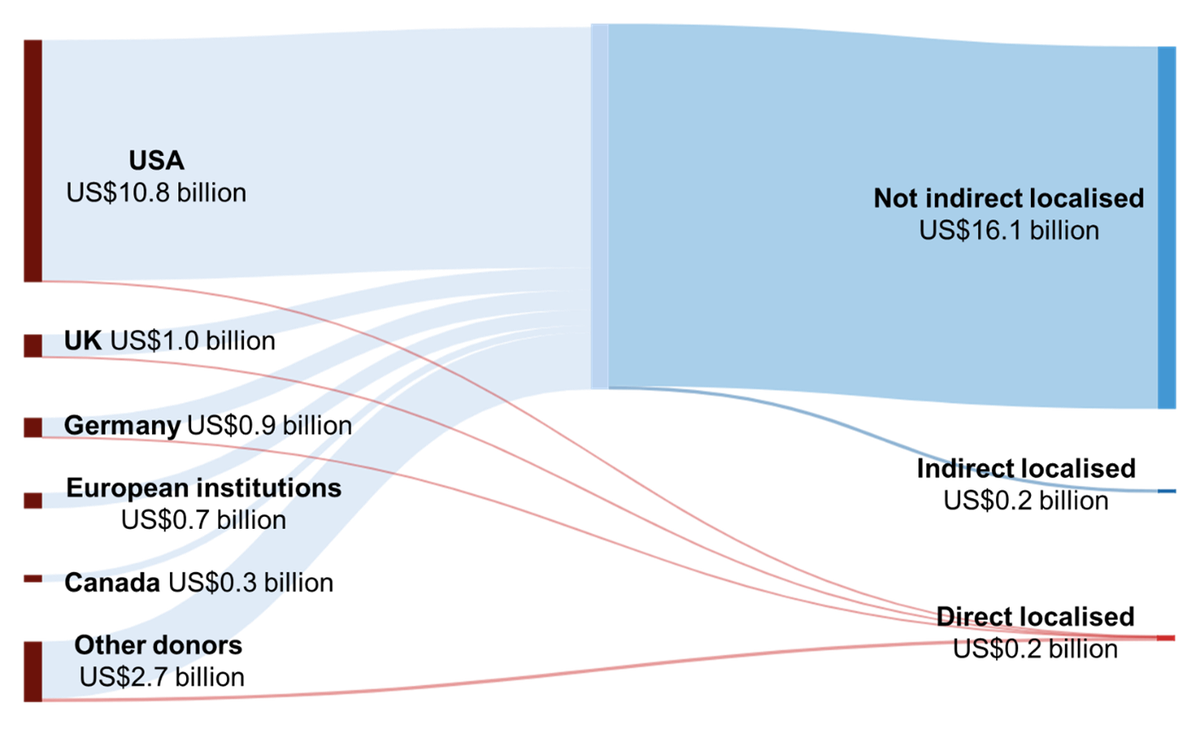
Sankey diagram showing top donors of food sector funding to South Sudan (USA, UK, Germany, European institutions, Canada, and other donors) and how this funding is split between direct localised, indirect localised and not indirectly localised. Diagram shows that US$16.1 billion funding is not indirectly localised, and just US$0.4 is localised in total.
Source: Development Initiatives based on UNOCHA FTS and UN CBPFs.
Notes: 2022 data is partial, and subject to change. Levels of localisation are poorly reported beyond the first level of funding.
Tracking funding to LNAs is limited to the first recipient on the transaction chain; it may be that LNAs are receiving more food sector humanitarian funding but intermediaries are not reporting it. LNAs interviewed in South Sudan have unanimously stated that not enough money is passing through the transaction chain to them. [66] Of what can be seen, less than 3% (US$389.8 million of US$16.1 billion) of food sector funding from the top 5 donors went directly to LNAs in the Horn of Africa region between 2017–2022.
- The US is the largest donor of food sector humanitarian funding to the Horn of Africa region in 2017–2022 with over US$10.7 billion in funding. Only US$64.3 million of this went directly to LNAs.
- Since the Grand Bargain in 2016 only three of the top five donors (Germany, United States and United Kingdom) have committed any money directly to LNAs in South Sudan (0.1%, 0.6% and 2.1% respectively of their individual food sector expenditures to the country).
- In South Sudan from 2017–2022, direct food sector humanitarian funding to LNAs from the top five donors represented just 0.1% (US$2.8 million) of all food sector humanitarian funding.
LNAs interviewed in South Sudan described a self-perpetuating cycle that prevents more localised funding. Barriers to funding such as conflict, fragility and a lack of capacity are reinforced by continued lack of funding. The lack of overheads and the reimbursement process, where organisations spend on interventions and are then compensated by indirect donors, have also been described as barriers to delivery, because organisations are reluctant to invest in work if it puts them at financial risk. [67] The instability that results from both precarious financial arrangements and insecure staffing means that LNAs are not able to operate effectively or fully realise benefits. These half measures may be contributing to overall cycles of crises: a local organisation that provides food relief but cannot conduct resilience-building activities leaves the community continuously vulnerable to the next shock.
Box 5
Cash and voucher assistance (CVA)
The most recently available data on global volumes of humanitarian CVA points to a continued increase in 2022, though contextual factors continue to impact the scale of CVA activities across countries experiencing crisis. Cash and voucher assistance programmes have been shown to work equally well at improving food security, to cost less than food distribution, and, in some cases, stimulate local economies. [68] The World Food Programme found that in countries dependent on small scale farming, households receiving cash transfers were demonstrably more resilient to the shocks from food insecurity and climate change impacts. [69]
However, the preference for, and effectiveness of, CVA is context dependent. In some cases, CVA has driven up the market price of food, and without other interventions, CVA has no demonstrable impact on the quality of nutrition in an area. [70] In areas without physical access to a market or an easy way to access transfers made via mobile, individual recipients often prefer food aid to cash or voucher assistance. [71] Nevertheless, project and funding data shows that projects with CVA components are more than twice as likely as other projects to be funded .
The 2022 South Sudan HRP calls for the use of CVA according to feasibility, effectiveness, efficiency and economy, and notes that unconditional cash will predominately be used for the purchase of food. [72] Interviews with LNAs in South Sudan cited multiple uses for CVA, from food to commodities that were usually imported, seeds for farming, or building materials for homes lost to flooding.
LNAs demonstrated a mixed preference for CVA. Those who used it sparingly or preferred food assistance noted the difficulty of monitoring the final use of the amount given to individuals or households. CVA also carried risks in the context of conflict, where both the distribution of cash posed a security threat and a heightened risk of gender-based violence. For those who supported the continued and increased use of CVA, cash was seen as less time-consuming or expensive than other interventions and as supportive of the local economy. [73]
Development finance
The interplay between development and humanitarian food sector finance is critical to mitigating the severity of food insecurity in South Sudan. In addition to life-saving relief in the most critical places, there is a need to build resilience in subnational regions facing less severe food insecurity, particularly through climate-resilient agriculture and cooperative, mechanised processes that create bumper crops and avoid the devastating climate-related losses to subsistence crops. LNAs interviewed in South Sudan have advocated for a more strategic implementation of finance across the nexus, but as the crisis in some communities worsens, humanitarian resources are often diverted to those worst-hit. [74]
The vast majority of food sector humanitarian spending in the Horn of Africa region has been for food insecurity, whereas most development spending has been on agriculture and livelihoods (resilience-building). While resilience-building funding has been steadily increasing for the last seven years, it is still eclipsed by spending on food security. [75]
Figures 8a and 8b: Development funding to food sectors has remained at comparatively low levels in South Sudan, due to a lack of funding for agriculture
Horn of Africa region and South Sudan food sector humanitarian and development funding
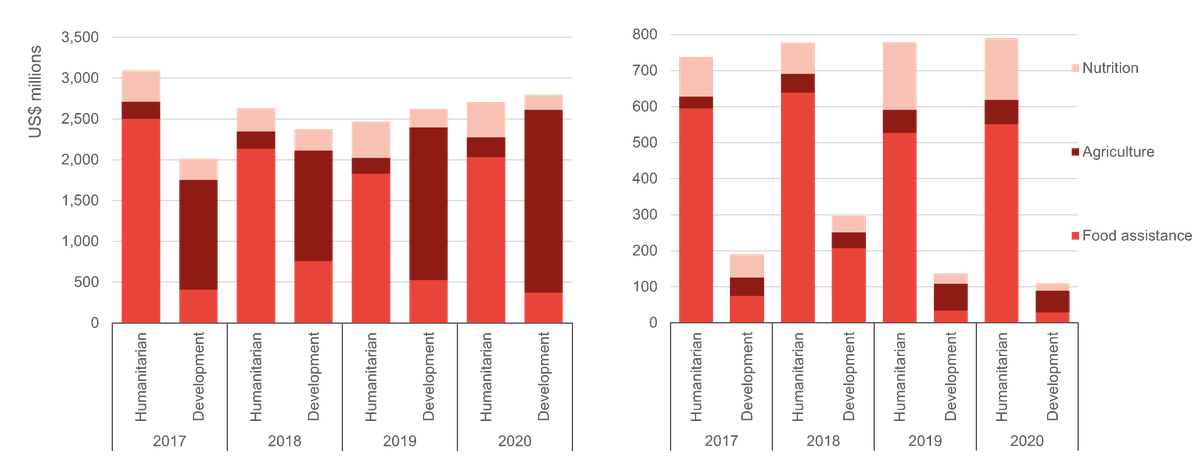
Two stacked column charts showing development funding per sector to Horn of Africa and South Sudan, showing very low levels of development funding in South Sudan primarily due to lack of agriculture funding.
Source: Development Initiatives based on UNOCHA FTS, OECD DAC CRS and UN CBPFs.
Notes: Development funding data is only available up to 2020.
Theoretically, the need for a large-scale humanitarian response should decrease as resilience increases. These figures suggest that either the size and scale of humanitarian crises have significantly increased in the last seven years, or that resilience-building activities are in some way insufficient – whether that be in size or form – to prevent or mitigate the worst effects of crises.
Development food sector spending, most of which is focused on agriculture and livelihoods, has increased across the Horn of Africa region since 2017, comprising half (51%) of nearly all food sector funding (US$2.8 billion of US$5.5 billion). However, in 2020 South Sudan received just 12% of food sector funding as development (US$109.4 million of US$899.6 million), and the proportion of that (55%) targeting resilience-building was far less than in other countries in the Horn of Africa region (80%).
Lack of transparency about different funding streams and how they interact to prevent crises creates an overreliance on the humanitarian system to perform all functions from crisis prevention to response. LNAs interviewed in South Sudan have resoundingly called for more agricultural funding from the food security and livelihoods cluster and pooled funds to make South Sudan more resilient to food security crises, including support for mechanised cooperative farming, hybrid seeds and other projects that can especially mitigate natural hazards, and competition over the small humanitarian resource available limits the scope and scale of those projects.
South Sudan has received relatively little climate finance from multilateral funds and climate-related ODA. Fragile and conflict-affected states (FCAS) in Africa on average receive less multilateral climate adaptation finance than non-FCAS countries and have received only 14% of total global multilateral climate finance.
- The only multilateral climate finance project to South Sudan from the Global Environment Facility (GEF) – for watershed approaches to climate resilience in agro-pastoral landscapes – for US$9.4 million was approved as a grant in 2019 but has not reported any disbursements. [76]
- Between 2018 and 2020, South Sudan received US$304.9 million in climate-related ODA, just 2% of the overall total country-allocable climate-related ODA to Africa of US$22.4 billion.
- Over the same period, Kenya and Ethiopia were respectively allocated 9.9% (US$2.2 billion) and 9.4% (US$2.1 billion) of total country-allocable climate related ODA , together accounting for the largest percentage of climate-related ODA to Africa.
LNAs interviewed in South Sudan spoke of the ‘continuous emergency’ caused by donors’ aversion to funding necessary resilience activities, which would require a longer-term investment, but are seen as imperative in the context of accelerating climate impacts and continuing cycles of flooding and drought. With increasingly urgent food relief needs, organisations are forced to prioritise life-saving humanitarian response, deprioritising recovery and reconstruction and the associated resilience. Yet these LNAs also spoke of a ‘ceiling’ for the emergency food requests and decreasing resources from the donor communities. [77]
Multiple LNAs called for funding to train people in new cultivation methods and to address the gap in livelihoods during the dry season. These activities are seen as way to increase resilience and reduce the dependency on food relief, engage in disaster risk reduction, ease food and climate-related pressures on conflict and mitigate the health impacts that came from inadequate shelter, forced displacement, GBV and water-borne illnesses. Current funding for local actors is short term, making it difficult to realise long-term impacts from projects related to resilience building against food insecurity. In addition to resources for disaster management, LNAs interviewed in South Sudan called for more coordinated actions anticipating, mitigating and preparing for long term solutions. [78]
With overstretched humanitarian finance, little development finance for agriculture and livelihoods, and insufficient and inaccessible climate finance, South Sudan is increasingly vulnerable to not only climate change impacts, but other risks that exacerbate and deepen crises, leaving it unlikely to emerge from either the worst forms of protracted crises or food insecurity and likely to remain continuously reliant on humanitarian assistance.
Conclusion
The figures reported here show that the Horn of Africa region, and South Sudan specifically, have experienced continuous food insecurity, recurrent and protracted crises. Food security to the region has worsened across a number of metrics, including the number of people experiencing food insecurity and the intensity of food insecurity. Food sector humanitarian spending has largely stagnated over the past six years, suggesting a game of whack-a-mole in which money is moved from crisis to crisis around the Horn of Africa region and nothing but the most extreme suffering is alleviated. Funding per capita for food insecurity in the countries experiencing intersecting dimensions of risk and with humanitarian response plans has decreased. Funding to LNAs continues to be insufficient in 2022, and competition over increasingly scarce resources has increased.
It can be difficult to emerge from these conditions, which themselves are contributing vulnerabilities to crises. Countries experiencing protracted crises are more likely to experience food insecurity, and as less money for humanitarian spending becomes available even as more is spent on food security, the threat from other vulnerabilities remain and resilience is more difficult to build. In the case of South Sudan, LNAs are able to demonstrate how and when resources can be more effectively targeted to meet the specific contextual needs but this, critically, requires a mechanism that can respond to these recommendations ‘before disaster strikes’. [79]
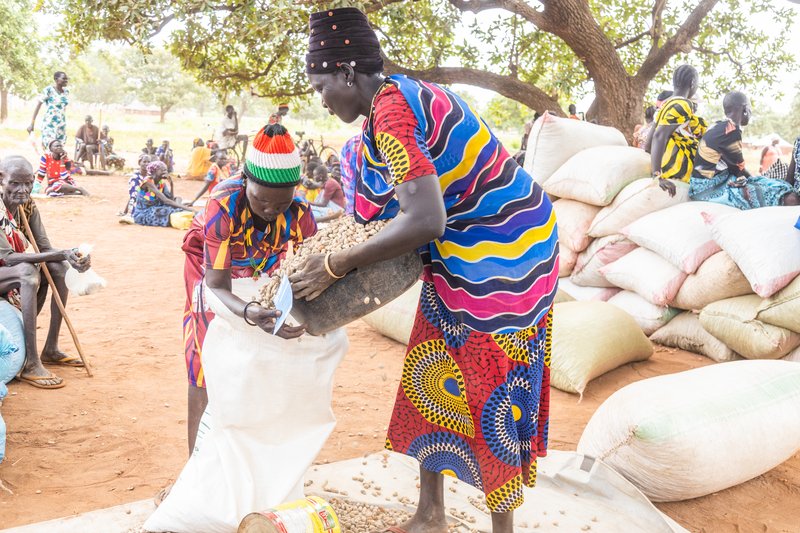
Despite an increase in development spending in the region overall, resilience building has been insufficient, and, in the case of South Sudan, woefully inadequate. The extended conflict and the insecure operating context, along with consistently severe food insecurity, point to a need for coherence and coordination across the humanitarian–development–peace nexus. LNAs interviewed in South Sudan suggest that there is a need to meet both humanitarian and longer-term development priorities in order to avert further crisis.
More research over time could evaluate the effectiveness of co-designed food security and resilience-building projects, as well as the scope and level of support of the national government for these activities. Further research can also demonstrate how priorities in the region have shifted, how allocations have changed, and whether sustained resilience-building activities in specific areas have had a significant impact on humanitarian food sector spending. Project and community level data could measure the progress interventions have made and the types of specific shocks that disrupt them, whether they be conflict, youth agitation, neighbouring problems or climate-driven. Comparative case studies can also demonstrate the difference in impact when local organisations have greater involvement and receive larger, more consistent funding allocations.
Protracted crises and the accelerating and constant changes brought about by climate change impacts highlight the importance of a multi-faceted crisis response that includes relief, recovery and resilience building. For places experiencing prolonged conflict or cyclical shocks, progress cannot be achieved without an aligned humanitarian, development and peacebuilding response which addresses both climate impacts and drivers of crisis.
Case Study
South Sudan Hub in partnership with Start Network: A country-level platform to enable locally-led humanitarian action
One option to strengthen quality funding and partnership with local actors is a series of hubs: collectives of local, national and international organisations of humanitarian responders operating in the same country or region. Start Network is supporting hubs driven by local needs around the globe and is currently scoping the establishment of one in South Sudan. Local, national, and international NGOs in South Sudan have come together to design a hub that can build on existing capacities and partnerships to provide a platform for locally-led humanitarian response, but also innovation and advocacy. There is a clear plan to transition from INGO (CAFOD) support to local leadership, in order to rapidly respond to areas understood to need the strongest interventions.
Experience from hubs in other contexts has already demonstrated the impact of working differently and these new approaches are already incorporating climate change impacts. For example, in Pakistan, hub members have acted early based on scientific and community-based trigger models for flooding, heatwave, and drought. In Somalia, a drought insurance payout purchased by Start Network and provided by African Risk Capacity as part of the ARC programme has just been activated to address food insecurity resulting from another failed rainy season. These funds will be largely delivered based on pre-arranged contingency plans and collaborative arrangements by the members of the locally-led hub.
A more proportionate, tiered approach to due diligence is another area of innovation for Start Network and the hubs, enabling local NGOs access to incrementally greater amounts of funding appropriate to their organisational and compliance capacity. As such, the South Sudan Hub, in partnership with Start Network, aims to contribute to a vision of a locally-led humanitarian system; shifting power to national and local actors, whilst leveraging the potential for complementarity and partnership between international, national, and local actors.
Six years on from the Grand Bargain, the case of South Sudan suggests that in the worst emergencies and in the most extreme fragile contexts, donor and intermediary organisations are hesitant to trust local actors as capable, knowledgeable and effective. There is still a sense that there is insufficient resource beyond immediate lifesaving needs and that solutions developed without the nuance of specific operating contexts are shoehorned into cases like South Sudan.
Local organisations in South Sudan that have legitimacy within the community concur that the path out of these cycles of crisis is through resilience-building activities, sufficient money for response, recovery and reconstruction, and support for the operating costs of local partners. In some cases, rather than be subjected to continuous cycles of losses, damages and accompanying crises, local organisations advocate for innovation in anticipation of more frequent and intense climate change impacts. They consistently call for more direct funding from donors to achieve these aims and a seat at the table where priorities and allocations are determined.
Notes
-
1
FAO, et al, 2022. The threat of starvation looms in East Africa after four failed rainy seasons. Available at: https://www.fao.org/3/cc0312en/cc0312en.pdfReturn to source text
-
2
Preliminary data based on UN OCHA Financial Tracking Service 2022. Available at: https://fts.unocha.org/appeals/overview/2022Return to source text
-
3
Oxfam, et al. 2016. Missed Out: The role of local actors in the humanitarian response in the South Sudan conflict. Available at: https://oxfamilibrary.openrepository.com/bitstream/handle/10546/606290/rr-missed-out-humanitarian-response-south-sudan-280416-en.pdf?sequence=1&isAllowed=yReturn to source text
-
4
Oxfam, et al. 2016. Missed Out: The role of local actors in the humanitarian response in the South Sudan conflict. Available at: https://oxfamilibrary.openrepository.com/bitstream/handle/10546/606290/rr-missed-out-humanitarian-response-south-sudan-280416-en.pdf?sequence=1&isAllowed=yReturn to source text
-
5
Anonymous interviewee, NGO (South Sudan). Interview conducted by Erica Mason, Development Initiatives, and Howard Mollet, CAFOD. 13 January 2023.Return to source text
Related content
Donors at the triple nexus
DI Senior Policy & Engagement Advisor Sarah Dalrymple presents some of our recent analysis into how donors like Sweden and the UK are approaching the triple nexus between humanitarian, development and peace approaches in crisis contexts.
Implications of coronavirus on financing for sustainable development
DI Executive Director Harpinder Collacott summarises the possible impacts of the coronavirus pandemic on global development - including projections for extreme poverty, the future of different forms of financing, and the countries likely to be most impacted.
What do emerging trends in development finance mean for crisis actors?
DI's webinar ‘What do emerging trends in development finance mean for crisis actors?’ gives crisis actors key information on development finance to better understand what it means for them.
